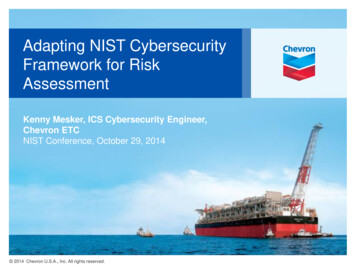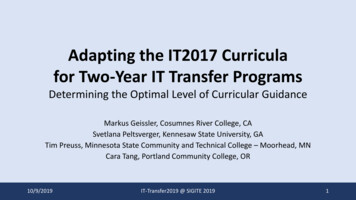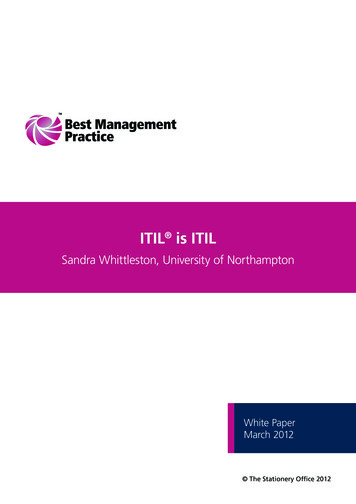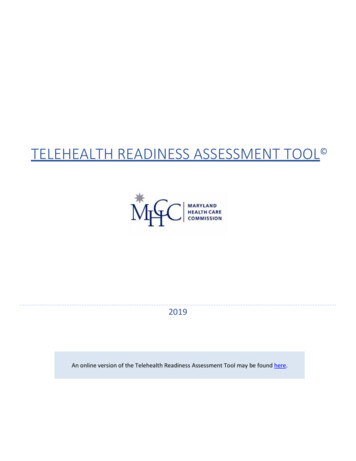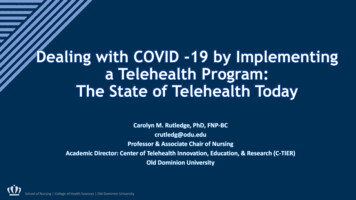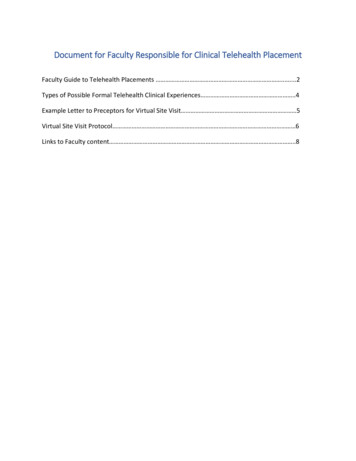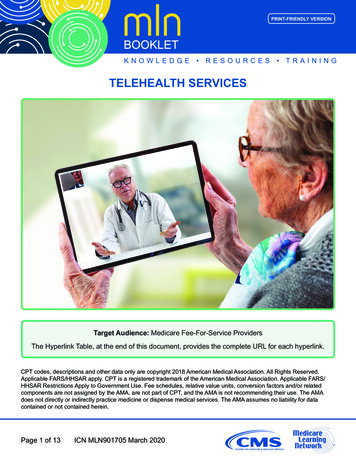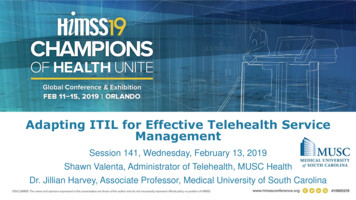
Transcription
Adapting ITIL for Effective Telehealth ServiceManagementSession 141, Wednesday, February 13, 2019Shawn Valenta, Administrator of Telehealth, MUSC HealthDr. Jillian Harvey, Associate Professor, Medical University of South Carolina1
Conflict of InterestShawn Valenta, RRT, MHA –Has no real or apparent conflicts of interest to report.Jillian Harvey, Ph.D –Has no real or apparent conflicts of interest to report.2
Agenda Telehealth Background Complexities of telehealth servicedevelopment, implementation, andsustainability Ideas for telehealth best practices:The structured framework3
Learning Objectives Recognize the complex factors that challenge effectivetelehealth service development, implementation andsustainability Describe the five phases of MUSC’s telehealth servicemanagement framework Identify key elements that contribute to a successful,sustainable telehealth service Explain how the RACI Matrix is applied to telehealthservice management4
Brief History of TelehealthVirtual Health: Aligning Solutions With Enterprise-WidePriorities. SG2 Intelligence 2014.
Background Obtaining timely healthcare services can be extremely challengingfor patients who reside in rural or medically underservedcommunities.1-2 Telehealth appeal Improve access Improve quality Reduce cost6
Concerns Yet, telemedicine programs not widespread3-5 Small scale services poorly integrated into healthsystems3, 6 Large-scale IT projects have failure rates 30%7 75% of successful telehealth pilots notsustained8-97
Telehealth ntPlanning & BestPracticesResourceIntensive4, 7, 10, 15Assessment &Evaluation8
Telehealth Complexity“Organizationally, telemedicine provides challenges to thetraditional notions of regionalized health care systems”(Bashshur, 2007) Persistent problems have not been successfullyaddressed:4, 16– Relationships between traditionally competing deliverysystems culture, practices, business models, governance– Telehealth organizational structure– Operational system– Boundaries of planning regions9
Telehealth Evidence Base11-14Strengthof EvidenceStrengthof EvidenceProgram Strategy &ImplementationOutcomes forCertain SpecialtiesDelivery & PaymentModelsCost esHome MonitoringPsychotherapySupportAccessTravel CostsPatient SatisfactionWait TimesTransportationProvider TechnicalSatisfaction10
Current telehealth literature includesmultiple & separate frameworks related to: 4, ion11
Factors that Impact Telehealth Success(Liezl van Dyk, 2014) Technology Organizational Structures Change Management Economic feasibility Societal impactsPerceptionsUser-friendliness Evaluation andEvidence Legislation Policy and governance“A holistic implementation approach is needed”12
Sustainable Telemedicine: Designing andBuilding Infrastructure to Support aComprehensive Telemedicine Practice(Mayo Clinic Experience)Analysis:1. “Strategy not clearly articulated”; priorities and scope not maintained2. Services created from different practice areas resulted in variation,creating further challenges in providing operational support across theenterprise3. Numerous stakeholders and competing priorities negatively impactedservice development4. Fragmented technology; no clear operational proceduresBeth L.H. Kreofsky, R. Nicole Blegen, Troy G. Lokken, Susan M. Kapraun, MatthewS. Bushman, and Bart M. Demaerschalk.Telemedicine and e-Health.Dec2018.ahead of printhttp://doi.org/10.1089/tmj.2017.029113
MUSC Center for Telehealth 13 years of telehealthexperience 70 unique telehealth services A HRSA-designated NationalTelehealth Center ofExcellence Coordinating entity of theSouth Carolina TelehealthAlliance (SCTA)Executive Medical Director: Dr. Jimmy McElligott14
Over 200 Connected Sites( 90% are non-MUSC)15
Volume of MUSC 001000005000001620142015201620172018
Evolution of MUSC’s TelehealthServices Created a lot of pieces to servicedevelopment (e.g. checklists) Experienced many growing pains “Concentration risk”2008Telestroke2005Maternal FetalTelemedicine2009ICUTelepsych2014-PresentMUSC Center for2013Telehealthcharged withStateacceleratedtelehealthgrowth offundinginfused by SC telehealth servicesLegislature17
Initial MUSC Telehealth Goal“Everything we do within our walls, we should do outside our walls”18
Case Study 1: Inpatient Pediatric GI Single provider ‘Customized’ workflow– Not consistent across comparableservices– Not mapped out– Confusion re: roles/responsibilities Poor communication with partnersites Inadequate training at partner sites No formalized evaluation planLow utilizationLow satisfaction19
Case Study 2: OutpatientTransplant Nephrology Lack of provider champion engagement Workflow–Everything to everybody multiple changes toworkflow–Not formally mapped out–Confusion re: roles/responsibilities Service goal a moving target delay and frustration No formalized governance–Response to partner site & internal providers multiple tech change High provider/staff turnover No pro forma & unrealistic volume expectations20
Processes to be Navigated inTelehealth Service DevelopmentProviderLegal engagementProcurementComplianceStrategy21
Discovered ITIL(Information Technology Infrastructure Library)- Created by UK in 1980’s- Detailed practices for ITservice management- Aligns services with businessneeds- Used worldwide:- US Governments (States,Navy, Army)- Industry (Disney, Honda,Visa)22
Adapted the Idea of ITIL toCreate the Telehealth ServiceImplementation Model(T-SIM )“Telehealth is a clinical service deliveredover an IT service” Provided terminology and a standard framework Highlighted strengths & weaknesses23
Telehealth ServiceImplementation Model (T-SIM )24
Telehealth Service Strategy Defines scope of the service Condition(s)Location of patientsType of providersWhat problem is beingsolved?Key Processes: Strategy ManagementDemand ManagementPortfolio ManagementFinancial Services ManagementBusiness Relationship Management(BRM)Value Creation25
Thinking beyond “replicating care over distance”MUSC Mission statement: “Telehealth for efficient,effective care”Assess the impact on stakeholders:1) Patients2) Referring providers3) Consulting providers4) Payers5) Health system (as a whole)Prioritize services that: Add efficiency to care teams Add value to care over the continuum Mitigate time and distance barriers to care26
Telehealth Standardized Scoring ToolSupport of implementation Physician champion Provider capacity Strategic alignmentPotential impact Quality Cost Access to careGrowth opportunity Market size Saturation Demand27
Telehealth Cardinal SinsSetting up a telehealth program:1. without provider engagement &availability2. without a clear path from patient totechnology3. without an evaluation plan4. untethered from organizational strategy28
Telehealth Service Design Implement a commonarchitecture Understand each “site of care”has different rules Draft clinical and operationalprotocols Customize test scripts Identify KPI’s Navigate compliance, legal,credentialing and EHR issuesand processesKey Processes: Design CoordinationAvailability ManagementCapacity ManagementInformation SecurityManagementTraining Management (internalstaff, providers, sites)29
Design Coordination– maintain a common architecture for all activities and processesOperationsDesignStrategyDefine scope of the service Condition(s) Location of patients Type of providers What problem is st Scripts EquipmentTraining WorkflowTechnologyEquipmentand nistrativeLegalCredentialing- RegulatoryBilling ComplianceGo-LiveOutcomesPerformanceMetricsKPI TrackingMeet theneeds of thecustomers! Technology Precheck Dedicated Support Dedicated IT andOperational SupportOutcomesReporting30
RACI matrix through the common architecture31
Telehealth Service TransitionDesignOperations32
Telehealth Service TransitionMovement from test togo-live Training – tech and workflow Mock calls (alpha – internaltesting, beta – partner sitetesting)Key Processes: Transition Planning &Support Data & KnowledgeManagement Change Management33
Telehealth Service Operations High quality, reliable services Processes to manage“incidents” any unplanned event that has anegative impact on normaloperationsKey Processes: Incident ManagementProblem ManagementAccess Management34
Continual Quality Improvement Striving for high-reliability Preoccupation with failure Reluctance to simplify interpretations Sensitivity to operations Commitment to resilience Deference to expertise35
Summation Telehealth journey is complex Success is achievable Structured implementationframework is major catalyst36
QuestionsContact:Shawn Valenta, RRT, MHAAdministrator of Telehealth,MUSC Healthvalentas@musc.eduJillian Harvey, MPH, PhDAssociate ProfessorMUSC Dept of HealthcareLeadership & Managementharveyji@musc.edu*Please complete online session evaluation37
References1. American Telemedicine Association (2016). 2016 State Telemedicine legislation tracking. Retrieved ource/policy/state-legislationmatrix n 62. Wood, J., Mulrennan, S., Hill, K., Cecins, N., Morey, S., and Jenkins, S. Telehealth clinics increase access to care for adults withcystic fibrosis living in rural and remote Western Australia. Journal of Telemedicine and Telecare3. Kidholm, K., Ekeland, A., Jensen, L., Rasmussen, J., Pedersen, C., Bowes, A., Flottorp, S., & Bech, M. (2012). A model assessmentof telemedicine applications: MAST. International Journal of Technology Assessment in Healthcare, 28(1): 44-51.4. Van Dyk, L. (2014). A review of the telehealth service implementation frameworks. International Journal of Public Health, 11: 12791298.5. AlDossary, S., Martin-Khan, M., Bradford, N., Armfield, N. & Smith, A. (2017). The development of a telemedicine planning frameworkbased on needs assessment. J Med Sys, 41:746. Pelletier-Fleury, N., Fargeon, V., Lanoe, J.L., & Fardeau, M. (1997). Transaction costs economics as a conceptual framework foranalysis of barriers to the diffusion of telemedicine. Health Policy, 1-147. Jennett, P., Jackson, A., Healy, T., Ho, K., Kazanjian, A., Woolard, R., Haydt, S. & Bates, J. (2003). A study of a rural community’sreadiness for telehealth. Journal of Telemedicine & Telecare, 9:259-263.8. Berg, M.(1999). Patient care information systems and healthcare work: a socialtechnical approach. Int J Med Inform, 55:87-1019. Broens, T.H., Vollenbroek-Hutten, M.M., Hermens, H.J., van Halteren, A.T., Nieuwenhuis, L.J. et al. (2007). Determinants ofsuccessful telemedicine implementations: a literature study. Journal of Telemedicine and Telecare, vol. 13, no. 6, pp. 303309.10. Yellowlee11. Tuckson, R.V., Edmunds, M., & Hodgkins, M.L. (2017). Telehealth. The New England Journal of Medicine. 377:16, 1585-1592.12. Ashwood, J.S., Mehrotra, A., Cowling, D., & Uscher-Pines. (2017). Direct-to-Consumer telehealth may increase access to care butdoes not decrease spending. Health Affairs. 36(3).13. Edmunds, Margo; Tuckson, Reed; Lewis, Joy; Atchinson, Brian; Rheuban, Karen; Fanberg, Hank; Olinger, Lois; Rosati, Robert;14.Austein-Casnoff, Cheryl; Capistrant, Gary; and Thomas, Latoya (2017) "An Emergent Research and Policy Framework for Telehealth,"eGEMs (Generating Evidence & Methods to improve patient outcomes): Vol. 5: Iss. 2, Article 1. 14. HRSA. National Advisory CommitteeOn Rural Health and Human Services (2015). Telehealth in Rural America. Policy l/publications/telehealthmarch2015.pdf15. McIntosh, E. & Cairns, J. (1997). A framework for economic evaluation of telemedicine. Journal16. Bashshur, R., Reardon, T., & Shannon, G. (2000). Telemedicine: A new health care delivery system. Annu. Rev. Public Health.2000. 21:613-637.38
Explain how the RACI Matrix is applied to telehealth service management. Brief History of Telehealth Virtual Health: Aligning Solutions With Enterprise-Wide Priorities. SG2 Intelligence 2014. 6 Background Obtaining timely healthcare services can be extremely challenging for patients who reside in rural or medically underserved communities.1-2 Telehealth appeal Improve access .

